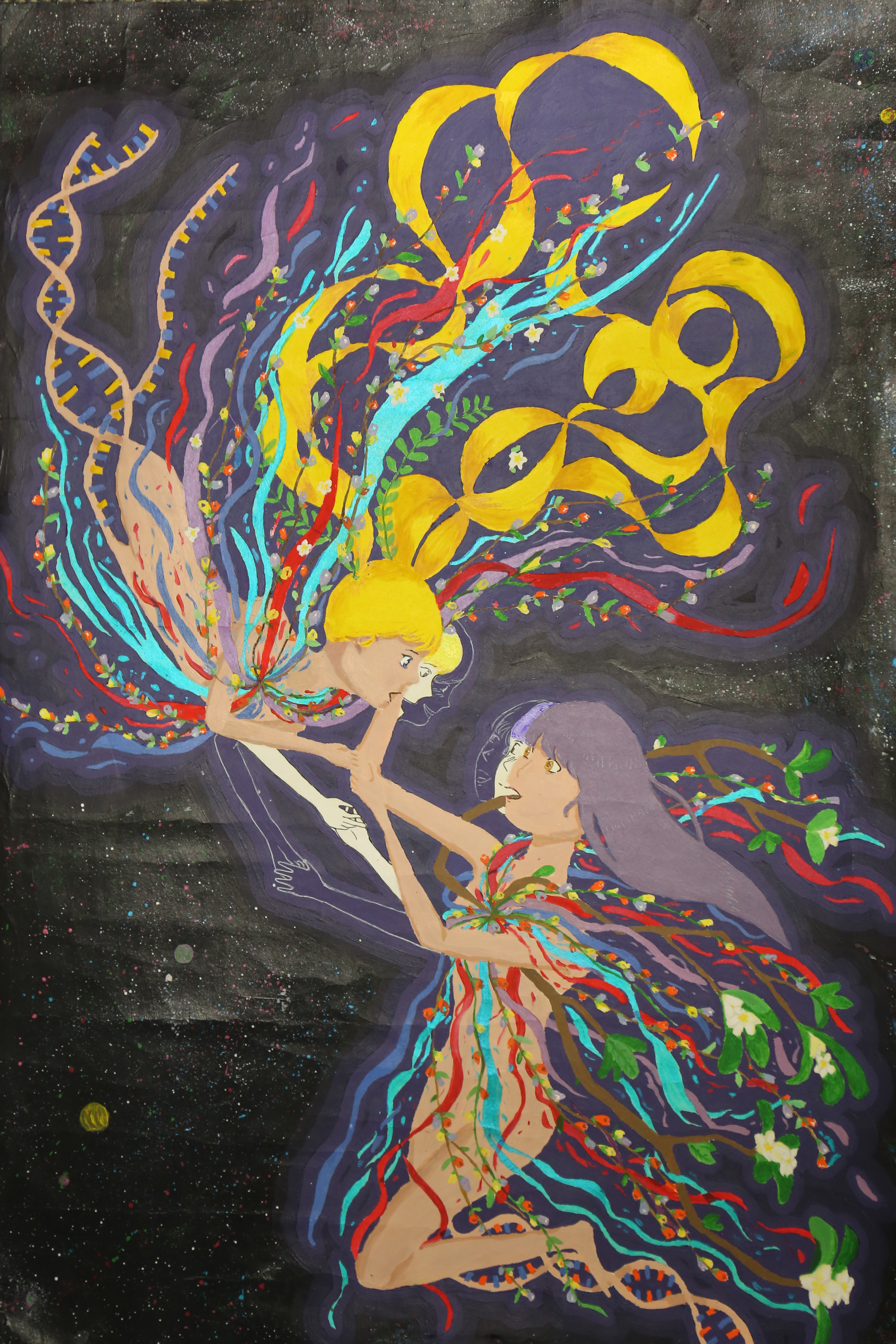
A visual representation of "Vanilla in the stars" by Agnes Lam
LI Yu Yin
Maryknoll Convent School (Secondary Section)
I am obsessed with the special connections between destined people after reading the poem.
They are originally fragments of the same star, and they keep finding each other when their lives are burning.
The relationships continue even after death and rebirth.
I am also fascinated by the poem’s description of the lives of stars, how they burn and transform into ashes with colourful gaseous light, thus mutating into plant and animal lives.
Our lives are similar to the lives of stars that they burn and finish up with something that can be regenerated and passed on.
As a result, I have decided into integrate these concepts in my artwork.
The painting depicts two people who are fragments of the same star.
During their search for each other, their lives are burning, as shown by their gradually disappearing bodies which are transforming into DNA for the next life.
Moreover, the star fragments within them continue to burn into gaseous light, returning to the universe.
The light then transforms into dust and plants, ready to nourish a new life.
The faces and hands drawn with a white pen represent their previous lives.
Discovering each other in their third life, they are surprised and delighted.
Vanilla in the stars
When I was a child,
I used to gaze at the stars above
our garden of roses, jasmine and lingzhi by the sea,
wondering how far away they really were,
whether they were shining still at the source
by the time their light reached me …
I was told that everyone was born with a star
which glowed or dimmed with the fortunes of each.
I also heard people destined to be close
were at first fragments of the same star
and from birth went searching for each other.
Such parting, seeking, reuniting might take
three lifetimes with centuries in between.
I had thought all these were but myths …
Now decades later, I read about the life of stars,
how their cores burn for ten billion years,
how towards the end, just before oblivion,
they atomize into nebulae of fragile brilliance –
ultra violet, infra red, luminous white, neon green or blue,
astronomical butterflies of gaseous light
afloat in a last waltz choreographed by relativity,
scattering their heated ashes into the void of the universe …
Some of this cosmic dust falls onto our little earth
carrying hydrocarbon compounds, organic matter
able to mutate into plant and animal life,
a spectrum of elemental fragrances …
Perhaps on the dust emanating from one ancient star
were borne the first molecules of a pandan leaf,
a sprig of mint or basil, a vanilla pod, a vine tomato,
a morning frangipani, an evening rose, a lily of the night …
Perhaps our parents or grandparents or ancestors further back
strolling through a garden or a field had breathed in the scents
effusing from some of these plants born of the same star
and passed them on as DNA in the genes of which we were made …
Could that be why, on our early encounters, we already sensed
in each other a whiff of something familiar, why, when we are near,
there is in the air some spark which seems to have always been there,
prompting us to connect our pasts, share our stories even as they evolve …
… till the day when we too burn away into dust
and the aromas of our essence dissipate
into the same kaleidoscope of ether light
to be drawn into solar space by astral winds …
… perhaps to make vanilla in a star to be
before the next lifetime of three?
Agnes Lam
“Vanilla in the Stars” was first published as: Lam, Agnes. (2009). Vanilla in the stars. In P. Amato & M. J. Salfran (Eds.), Nosside 2008: XXIVth Poetry Prize anthology (pp. 89-92). Reggio Calabria: Centro Studi Bosio, Italy. (Published in English and Italian.)